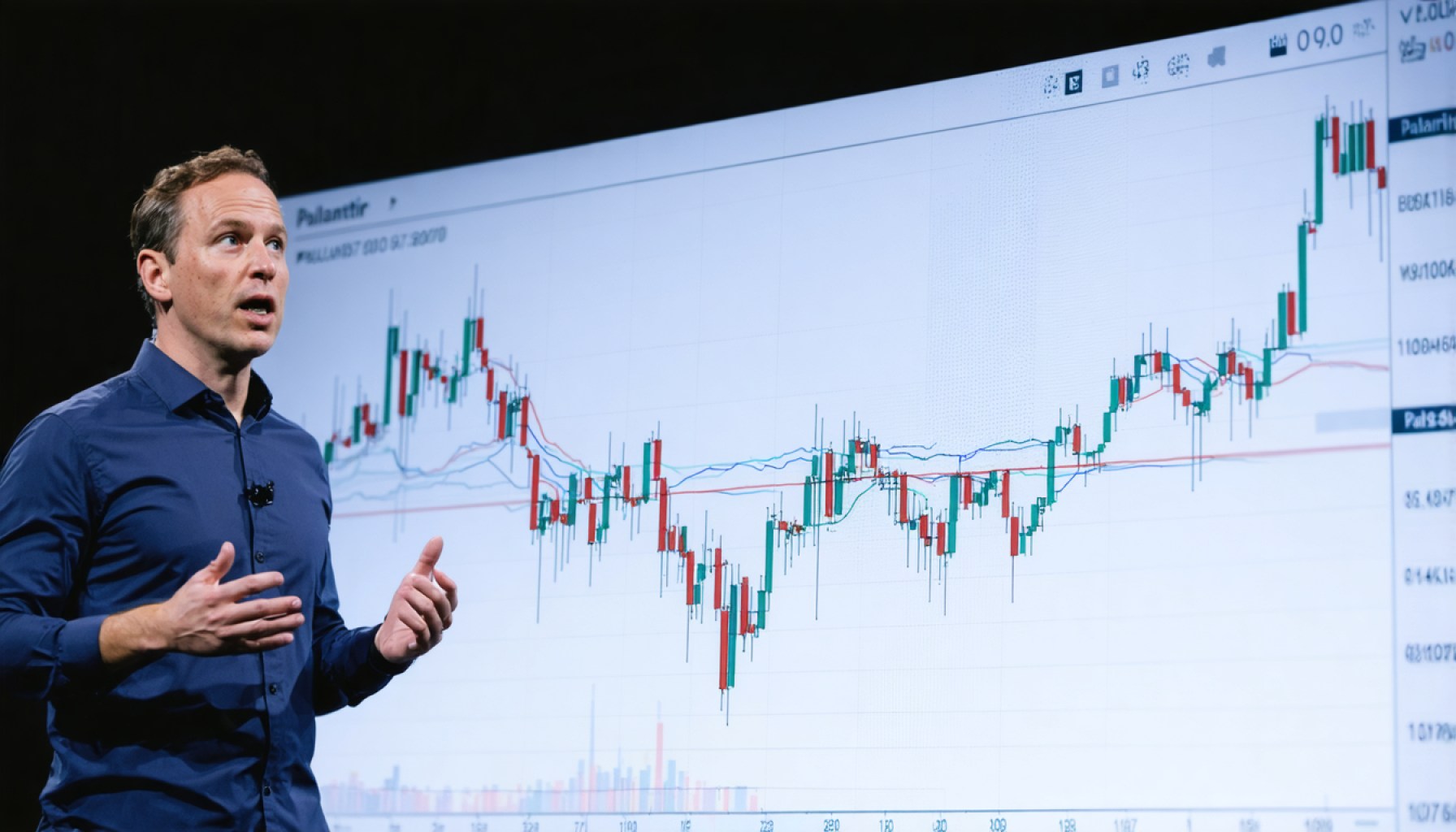- Palantir Technologies’ stock dropped 10.6% after new tariffs announced by President Trump, escalating the U.S.-China trade war.
- Despite its software focus, Palantir felt the market panic as indices like S&P 500 and Nasdaq Composite fell over 5%.
- The looming economic downturn might impact Palantir’s growth, as companies could cut back on software spending.
- Palantir’s high P/E ratio above 400 highlights its precarious position amidst market uncertainty.
- Analyst opinions on Palantir vary, with stock price projections ranging from $40 to $125, though a “Hold” recommendation predominates.
- At the end of Friday, Palantir’s stock was at $74.48, with a market cap of $17.47 billion, showing high trading volumes despite recent declines.
- The situation underscores the volatility of growth stocks amid geopolitical and economic uncertainties.
Amid the uncontrollable storm of a global trade war, Palantir Technologies found itself caught in the crossfire, with its stock taking a sharp nosedive on a tumultuous Friday. The data analytics giant experienced a staggering 10.6% fall on the heels of President Donald Trump’s announcement of sweeping new tariffs. This maneuver marked the latest bout in an intensifying trade battle with China, which swiftly retaliated with matching tariffs on U.S. goods.
The market reverberated with anxiety, as key indices like the S&P 500 and Nasdaq Composite slid with palpable urgency, losing more than 5% of their value. Palantir, typically insulated from direct tariff impacts due to its focus on software solutions rather than physical goods, was not immune to the widespread panic. As the possibility of a recession looms large, concerns over an economic downturn could potentially threaten the expansive growth Palantir has enjoyed.
In challenging economic climates, it’s not uncommon for companies to pull back on discretionary spending, including software and AI solutions that form Palantir’s core business. This potential tightening of budgets places an ominous cloud over the company’s growth prospects, compelling analysts and investors alike to reassess Palantir’s standing. Despite a 40% decline over recent months, the company’s momentous P/E ratio—a daunting figure above 400—leaves it precariously perched amidst the current uncertainty.
Wall Street’s pulse reveals a complex mix of skepticism and optimism. Analysts’ forecasts for Palantir’s stock price scatter from a low of $40 to a high of $125, with an average projection suggesting a 20% climb from current levels. Yet, these optimistic forecasts clash with a predominantly “Hold” recommendation from analysts, underscoring the ambivalence surrounding Palantir’s ability to weather the storm.
At the close of Friday’s trading, Palantir stood at $74.48, the weight of recent events pulling it down from an intraday peak of $80.79. Its market cap has seen dramatic contraction, now hovering around $17.47 billion, yet the resilience of investor interest remains palpable, demonstrated by trading volumes that broke through the norm.
Far from its 52-week highs, Palantir’s narrative serves as a cautionary tale of volatility in the high-stakes world of growth stocks, where market sentiment can twist with startling velocity. As the trade dispute brews with escalating fervor, the path forward for Palantir appears fraught with both challenges and opportunities, a testament to the ever-evolving landscape of global economies and investor psyches.
The takeaway from this rollercoaster ride is clear—navigating an unpredictable market landscape demands a deft balance between ambition and pragmatism, a lesson underscored by Palantir’s reality check amidst the chaos.
Palantir Technologies: Navigating Volatility in a Tumultuous Market
Understanding Palantir’s Position in a Shifting Global Economy
Amid the intricacies of a global trade war, Palantir Technologies found itself in an unexpected storm despite its focus on software rather than physical goods. The company experienced a stark 10.6% stock drop following new U.S. tariffs on Chinese imports and China’s retaliatory measures. This attention to broader economic impacts provides insight into how even technology giants must heed geopolitical tensions.
Real-World Use Cases and Industry Implications
Palantir’s core business revolves around data analytics and AI solutions for government and private sectors, offering critical market insights:
1. Government Agencies: Palantir’s software helps defense and intelligence agencies analyze vast data for national security purposes. Increased geopolitical tensions can actually benefit this aspect of its business, as governments may augment analytics investments to enhance strategic decision-making capabilities.
2. Healthcare: Its software aids hospitals and research facilities in analyzing patient data for better healthcare outcomes. As healthcare remains a priority, even in downturns, Palantir’s services in this sector might see sustained demand.
Market Forecasts and Industry Trends
Despite the current market flux, some analysts foresee a positive trajectory for Palantir:
– Analyst Projections: With stock price forecasts ranging from $40 to $125, the average suggests a potential 20% increase from the current trading level. This indicates a cautious optimism that Palantir can navigate macroeconomic challenges.
– Industry Trends: The increasing reliance on big data analytics across industries positions Palantir favorably, particularly in sectors resilient to economic downturns, like healthcare, defense, and critical infrastructure.
Challenges, Controversies, and Limitations
– High P/E Ratio: Palantir’s P/E ratio, above 400, reflects concerns over its current valuation amidst uncertain economic conditions. High P/E ratios typically signal expectations for future growth, but they also imply significant risk if growth fails to materialize.
– Market Sentiment: The prevailing “Hold” recommendation accentuates the divided opinion among investors concerning Palantir’s prospective performance amidst ongoing market volatility.
Security and Sustainability
Palantir places a premium on data security, ensuring robust encryption and compliance with data privacy regulations—vital for maintaining trust with high-profile clients in government and healthcare sectors.
Insights and Predictions
– Potential Growth Sectors: Emerging technologies, like artificial intelligence and machine learning, offer significant growth opportunities for Palantir, particularly as these fields continue gaining traction globally.
– Geopolitical Influence: Continued geopolitical instability could provide a dual-edged sword, driving government contracts while potentially disrupting international business operations.
How to Adapt Your Investment Strategy
1. Diversification: Incorporate a mix of industries in your portfolio to mitigate risk exposure from volatile sectors.
2. Long-Term Outlook: Focus on companies with robust fundamentals and strategic positioning in growth markets, such as analytics and AI.
3. Stay Informed: Regularly follow updates from credible financial news sources to adapt swiftly to any economic shifts.
Quick Tips for Investors
– Research: Analyze financial health indicators, like cash flow and debt levels, beyond just P/E ratios.
– Monitor News: Keep an eye on geopolitical developments, as they can significantly influence stock performance in companies like Palantir.
– Consult Experts: Engage with financial advisors to tailor investing strategies aligned with your risk tolerance and financial goals.
For further reading, explore investment insights on Palantir Technologies.
By weaving a tapestry of resilience and agility, investors can learn not just from Palantir’s journey, but navigate their own pathways through the unpredictable seas of global markets.











